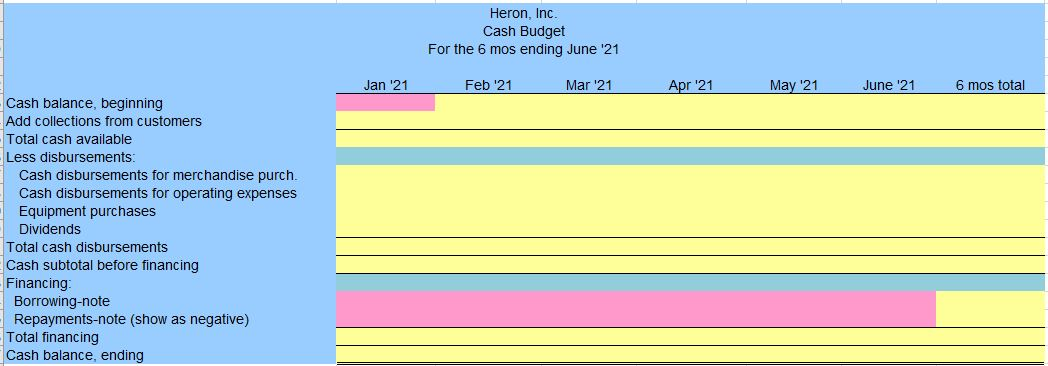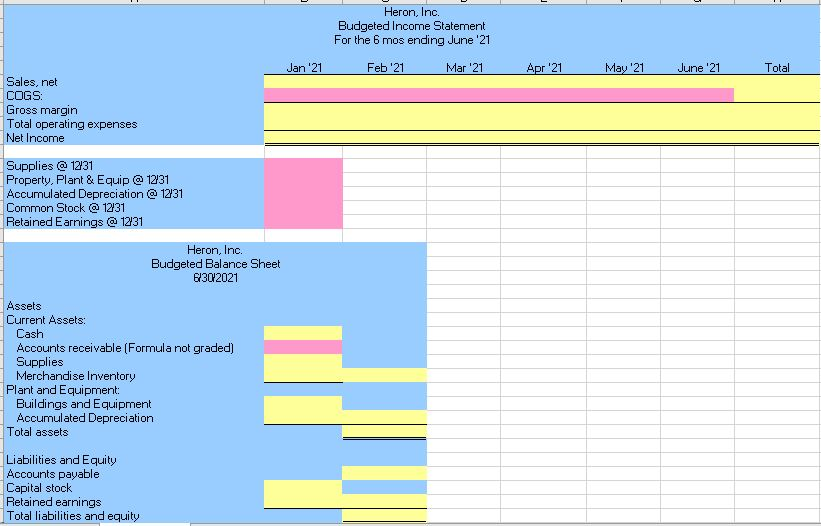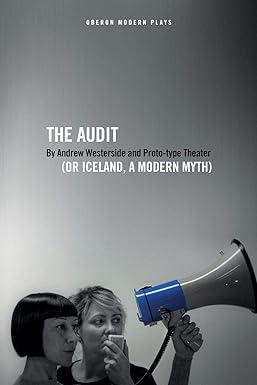Question
HERON INC. BUDGET PROJECT Requirements - Sales Forecast and Budget Cash Receipts budget Purchase budget Cash Purchases Disbursements budget Operating Expense budget Summary Cash budget
HERON INC. BUDGET PROJECT
Requirements-
- Sales Forecast and Budget
- Cash Receipts budget
- Purchase budget
- Cash Purchases Disbursements budget
- Operating Expense budget
- Summary Cash budget
- Budgeted Income Statement
- Budgeted Balance Sheet
Details-
Heron, Inc. is a company that re-sells one product, a particularly comfortable lawn chair. An overseas contractor makes the product exclusively for Heron, so Heron has no manufacturing-related costs. As of November 2020, each lawn chair costs Heron $4.50 per unit. Henron sells each chair for $10 per unit.The estimated sales (in units) are as follows:
| Nov 20 | 11,250 |
| Dec 20 | 11,500 |
| Jan 21 | 9,000 |
| Feb 21 | 11,400 |
| Mar 21 | 12,200 |
| Apr 21 | 15,600 |
| May 21 | 18,200 |
| June 21 | 21,542 |
| July 21 | 18,500* |
*You can type in this amount (instead of a cell reference) if you use this amount for a formula
- The company plans to raise the sales price to $11.25 per unit beginning May 1, 2021. The sales forecast (i.e., estimated sales in units) takes this price increase into account.
- Twenty-two percent of any months sales are for cash, and the remaining 78% are on credit. Thirty percent of the credit sales are collected in the month of sale, 56% are collected in the following month, and 9% are collected in the second month after the sale. The remaining receivables are deemed uncollectible. Bad debts are written off in the month the debt is deemed uncollectible (e.g. if the sale is made in January and is not collected by the end of March, it is written off in March.) No accrual for estimated bad debts is made in the month of sale.
- The firms policy regarding inventory is to stock (i.e. have in ending inventory) 38% of the forecasted demand in units (i.e., estimated sales) for the next month. Heron uses the first-in, first-out (FIFO) method in accounting for inventories.
- Forty-five percent of the inventory purchases are paid for in the month of purchase and the remaining 55% are paid in the following month (i.e. all of the previous months Accounts Payable are paid off by the end of any month.)
- Per a prior contract, a cash payment of $50,000 for equipment previously purchased in 2020 is due in January. Another payment of $25,000 is due in February. Depreciation on the equipment previously purchased is included in the overhead cost detailed in item 9 below. Also, dividends of $14,000 are to be paid in March.
- Monthly operating expenses consist of the following (if these are cash expenses, they are paid when incurred):
| Salaries and Wages | $3,500 |
| Sales Commissions | 6% of sales revenue |
| Rent | $7,500 |
| Other Variable Cash Expenses | 4% of sales revenue |
| Supplies Expense: See note | $1,500 |
| Other: See note | $51,000 |
Note: Other general and administrative overhead is expected to be $51,000 per month. Of this amount, $24,000 represents depreciation and the rest is other non-cash expenses. The company maintains on hand one months worth of supplies.
- The company must maintain a minimum cash balance of $15,000. Borrowing can make up shortfalls. For simplicity, assume that the bank will only lend (and accept repayments) in $1,000 increments. Ignore interest on the loan in your calculations, but minimize the amount borrowed and pay off any loans as soon as possible.
- The cash balance at the beginning of January is $15,000. There will be no notes payable as of this date.
- See below the other Balance Sheet accounts with their expected balances as of December 31, 2020:
- Supplies $1,500
- Property, Plant and Equipment $1,050,000
- Accumulated Depreciation $526,475
- Common Stock $200,000
- Retained Earnings $330,779
*Please answer this question similar to the following excel format*






Step by Step Solution
There are 3 Steps involved in it
Step: 1

Get Instant Access to Expert-Tailored Solutions
See step-by-step solutions with expert insights and AI powered tools for academic success
Step: 2

Step: 3

Ace Your Homework with AI
Get the answers you need in no time with our AI-driven, step-by-step assistance
Get Started


